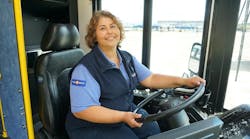A new report from TransitCenter looks at the bus operator crisis impacting transit by examining the many factors feeding the crisis and providing several solutions on how to combat against it.
The report, “Bus Operators in Crisis – The Steady Deterioration of One of Transit’s Most Essential Jobs and How Agencies can Turn Things Around,” is authored by Chris Van Eyken and frames the issue in bleak numbers:
- 71 percent of agencies reported to the American Public Transportation Association that service has been cut or delays have increased because of shortfalls in operators;
- Nine in 10 agencies state they have difficulty hiring new employees, with bus operations the most difficult to fill;
- Two-thirds of agencies report similar challenges with retention of workers.
The report says the operator shortage is resulting in delayed expansions, is a roadblock in the industry’s recovery from the extreme loss of ridership brought by the pandemic and is disproportionately impacting communities of color.
The report says outside of the pandemic, increased rates of retirement, recruitment struggles, concerns with safety and the perception that operator positions are not viewed as attractive are all compounding the challenge.
“While the problem is multifaceted, many of the solutions are well within the control of relevant agencies. By taking steps to improve the quality of the job now, agencies can develop a stable, healthy and satisfied 21st-century workforce,” the report states.
The report offers potential solutions federal and state governments and transit agencies can implement, but notes job quality should be made a priority among agencies and within the transit industry.
“Operators are the backbone of the transit industry—they deserve better compensation, paths for advancement and the opportunity to influence their working conditions. Agencies must also speed up hiring processes, introduce more flexibility into the job, improve operator facilities and amenities and implement additional health and safety measures—both to attract new entrants and retain existing employees,” the report said.
Solutions offered
The report puts forth eight steps to help boost both recruitment and retention of operators.
Improving hiring means getting more people interested in the door and the report says “agencies must make a more compelling pitch to potential hires.” This includes clearly communicating total compensation packages. It could also involve hiring bonuses and a bit of marketing magic by focusing on the operator role as a career path, not just a job.
Modernizing the hiring process by making applications web accessible, easy to find and shareable on social media platforms can broaden the potential hiring pool. The report also says applications should not sit unacknowledged. Additionally, agencies should find ways to help candidates without CDLs obtain them; the report says even if it’s covering the cost of permits and applications, that’s one less barrier the applicant must face.
The report urges starting salaries be competitive and considered middle class within the service area. There must also be a clear and fast path toward median wages that can serve as a retainment tool.
Employee health and wellness can be improved by better access to restrooms and improving employee facilities. Restroom access can be improved by working with community partners and businesses that could be compensated for allowing that access or routes can be adjusted to start, end and lay over at transit centers equipped with these facilities. Depots and break rooms offer an additional opportunity to put employee health and wellness at the forefront with improved spaces that offer physical activity, relaxation and rejuvenation.
Operators need better support in their care and lives and the report recommends agencies offer mentoring options, better mental health support and professional development.
Operator safety should be a priority, especially for bus operators who are rarely separated from the rest of the bus, leaving them vulnerable. Additional potential points of conflict, such as fare collection, should be removed from the operators’ responsibilities. On a final note, the report recommends improving bus stop accessibility, which will involve municipal partners, to allow easier boarding for people using mobility devices, which will keep operators in their seats and focused on customer service aspects of their job.
While the report recognizes the logistical challenges associated with giving operators greater control over their schedules, reducing the use of swing shifts, split shifts and mandated overtime will lessen the chances of burn out among operators. The report suggests offering pay differential for certain shifts can encourage all seniority levels to take shifts rather than leave them to new hires. Additionally, finding ways to support childcare or other caregiving needs will help employees with irregular shifts. The report suggests speaking to operators with children to ask what help may be needed.
On that note, the report encourages agencies to proactively engage operator feedback and identify issues before a crisis level is reached.
Solutions for the state and federal levels
The report also offers several suggestions on what could be implemented at the state and federal levels to help address the transit operator shortage.
The report recognizes while “transit agencies bear the primary responsibility for changing the working conditions” of operators, state governments can support and provide funding for transit operations, expedite CDLs and support and develop second change programs. A recent example of a second chance program is New Orleans Regional Transit Authority’s JOB1 Career Solutions On the Job Training partnership, which offers training for non-violent offenders who complete the requirements of the Louisiana State Penitentiary’s Auto Mechanic Apprenticeship Program upon release. The program was announced in December 2021 and entered its second phase in May 2022.
At the federal level, the report suggests driver safety be elevated to a national issue, an Interagency Task Force be formed, guidance around drug testing should be revised, new guidance and FAQs regarding which funding sources can be used to address the operator and mechanic shortage, launch a national campaign to recruit operators and mechanics and using public and media appearances from top U.S. Department of Transportation and Federal Transit Administration officials to spotlight the issue.
“To begin ending operator shortfalls, the transit industry as a whole must recognize the vital role that operators play and work to increase the attractiveness of the position. Transit operators are the backbone of the transit industry; they must be held in esteem and dealt with fairly if we wish to see a thriving transit industry,” the report concluded.
The full report can be found on TransitCenter’s website.

Mischa Wanek-Libman | Group Editorial Director
Mischa Wanek-Libman is director of communications with Transdev North America. She has more than 20 years of experience working in the transportation industry covering construction projects, engineering challenges, transit and rail operations and best practices.
Wanek-Libman has held top editorial positions at freight rail and public transportation business-to-business publications including as editor-in-chief and editorial director of Mass Transit from 2018-2024. She has been recognized for editorial excellence through her individual work, as well as for collaborative content.
She is an active member of the American Public Transportation Association's Marketing and Communications Committee and served 14 years as a Board Observer on the National Railroad Construction and Maintenance Association (NRC) Board of Directors.
She is a graduate of Drake University in Des Moines, Iowa, where she earned a Bachelor of Arts degree in Journalism and Mass Communication.




